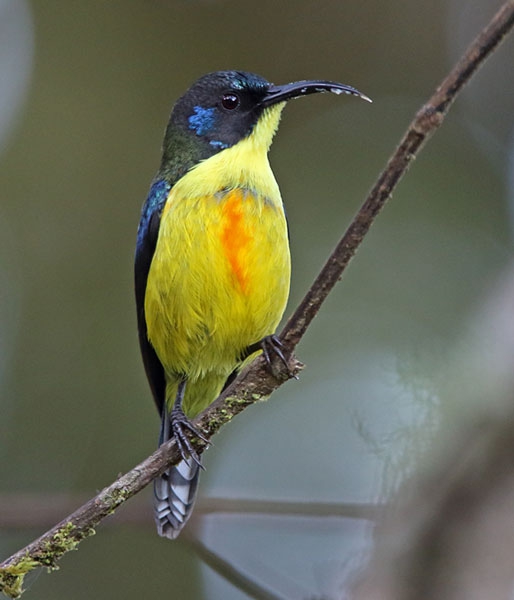| Citation |
|
Description |
Geographic Range [top]
Range Description: Aethopyga linaraborae is endemic to Mindanao, Philippines, where it is currently known from Mts Mayo, Puting Bato (Tagub) and Pasian in the eastern provinces of Davao del Norte and Davao Oriental. It is relatively common in suitable habitat within its altitudinal range; assuming that it occurs in all available remaining habitat above 1,200 m, its total range comprises 770 km2, but it is unlikely to be seriously threatened in the present or near future.
Countries occurrence:
Native:
Philippines
Additional data:
? Continuing decline in area of occupancy (AOO): No
? Extreme fluctuations in area of occupancy (AOO): No ? Estimated extent of occurrence (EOO) - km2: 2900
? Continuing decline in extent of occurrence (EOO): No ? Extreme fluctuations in extent of occurrence (EOO): No
? Continuing decline in number of locations: No
? Extreme fluctuations in the number of locations: No ? Lower elevation limit (metres): 1000
? Upper elevation limit (metres): 1980
Range Map: Click here to open the map viewer and explore range.
Population [top]
Population: The global population size has not been quantified, but the species is described as fairly common within its very small total range (Cheke et al. 2001).
Trend Justification: The population is likely to be stable given the rugged and inaccessible mountains within its range are generally are too steep for agriculture.
Current Population Trend: Decreasing
Additional data:
? Number of mature individuals: Unknown ? Continuing decline of mature individuals: No
? Extreme fluctuations: No ? Population severely fragmented: No
? Continuing decline in subpopulations: No
? Extreme fluctuations in subpopulations: No ? All individuals in one subpopulation: No
Habitat and Ecology [top]
Habitat and Ecology: It occupies montane mossy forest from 970-2,000 m and above. Breeding appears to take place in May, but may happen at other times of year.
Systems: Terrestrial
Continuing decline in area, extent and/or quality of habitat: No
Generation Length (years): 4.2
Movement patterns: Not a Migrant
Threats [top]
Major Threat(s): As it occurs in rugged and inaccessible mountains that contain few commercial tree species and generally are too steep for agriculture it is unlikely to face significant threats at present.
Conservation Actions [top]
Conservation Actions: Conservation Actions Underway
None are known.
Conservation Actions Proposed
Monitor potential threats within its altitudinal range. Grant protection to areas of suitable habitat to safeguard against future threats.
Citation: BirdLife International. 2016. Aethopyga linaraborae. The IUCN Red List of Threatened Species 2016: e.T22724518A94870302. http://dx.doi.org/10.2305/IUCN.UK.2016-3.RLTS.T22724518A94870302.en. Downloaded on 21 September 2018.
Disclaimer: To make use of this information, please check the .
Feedback: If you see any errors or have any questions or suggestions on what is shown on this page, please provide us with feedback so that we can correct or extend the information provided
|


